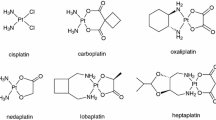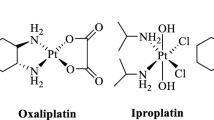This review describes various platinum complexes including heterocyclic fragments such as gemcitabine, satraplatin, fuplatin, etc. and covers data published over the last 20 years concerning the effectiveness of using platinum-containing drugs in antitumor therapy. Preparations of various genesis, structure, and intracellular conformations and possible mechanisms of action, biochemical properties, and some physicochemical parameters of these compounds are considered. Adducts of different nature and geometric structure have different intracellular repair reactions, cleavage of functional groups, and interaction with untwisted DNA in affected cells. In turn, molecules capable of targeted drug delivery of substances such as fullerenes and their water-soluble derivatives fullerenols as well as polymeric compounds (in particular, cucurbituril) used in the synthesis of platinum-containing biologically active compounds are gaining increased interest. Thus, research is also being conducted on selective targeted delivery of platinum-containing series with reduced toxicity in parallel with the search for the most effective compounds. This review cites data on biological modeling of the effectiveness, mechanism, and kinetics of active platinum-containing drugs. An important aspect is that all antitumor substances are synthesized under rational accessible conditions and have logical pathways for continuing work on the synthesis of analogs capable of stimulating the apoptosis of cancer cells.
Similar content being viewed by others
References
R. L. Siegel, K. D. Miller, and A. Jemal, Ca-Cancer J. Clin., 70(1), 7 – 30 (2020); https://doi.org/10.3322/caac.21590.
Z. M. Sarkisyan, Zh. Obshch. Khim., 90(10), 1522 – 1532 (2020); https://doi.org/10.31857/S0044460X20100078.
Z. M. Sarkisyan, Zh. Obshch. Khim., 90(9), 1460 – 1463 (2020); https://doi.org/10.31857/S0044460X2009019X.
D. Gibson, J. Inorg. Biochem., 217, 111353 (2021).
B. Rosenberg, L. Van Camp, and T. Krigas, Nature, 205(4972), 698 – 699 (1965); https://doi.org/10.1038/205698a0.
B. Rosenberg, L. Vancamp, J. E. Trosko, et al., Nature, 222(5191), 385 – 386 (1969); https://doi.org/10.1038/222385a0.
E. Wong and C. M. Giandomenico, Chem. Rev., 99(9), 2451 – 2466 (1999); https://doi.org/10.1021/cr980420v
A. F. Burnett, L. D. Roman, A. A. Garcia, et al., Gynecol. Oncol., 76(1), 63 – 66 (2000); https://doi.org/10.1006/gyno.1999.5657.
J. B. Sorensen, L. E. Stenbygaard, P. Dombernowsky, et al., Ann. Oncol., 10(9), 1043 – 1049 (1999); https://doi.org/10.1023/a:1008352900990.
R. R. Plentz and N. P. Malek, Visc. Med., 32(6), 427 – 430 (2016); https://doi.org/10.1159/000453084.
V. Heinemann, H. Wilke, H.-G. Mergenthaler, et al., Ann. Oncol., 11(11), 1399 – 1403 (2000); https://doi.org/10.1023/a:1026595525977.
J. Holford, S. Y. Sharp, B. A. Murrer, et al., Br. J. Cancer, 77(3), 366 – 373 (1998); https://doi.org/10.1038/bjc.1998.59.
J. Zhang, X. Wang, C. Tu, et al., J. Med. Chem., 46(16), 3502 – 3507 (2003); https://doi.org/10.1021/jm020593j.
R. Zhang, X.-Q. Son, R.-P. Liu, et al., J. Med. Chem., 62, 4543 – 4554 (2019); https://doi.org/10.1021/acs.jmedchem.9b00128.
Z. Dong,W. Zheng, and Z. Xu, J. Appl. Polym. Sci., 130, No. 2, 927 – 932 (2013); https://doi.org/10.1002/app.39247.
Y. Shi, S.-A. Liu, D. J. Kerwood, et al., J. Inorg. Biochem., 107(1), 6 – 14 (2012); https://doi.org/10.1016/j.jinorgbio.2011.10.012.
Y.-R. Zheng, K. Suntharalingam, T. C. Johnstone, et al., J. Am. Chem. Soc., 136(24), 8790 – 8798 (2014); https://doi.org/10.1021/ja5038269.
B. W. Johnson, M. W. Burgess, V. Murray, et al., BMC Cancer, 18(1), 1284 (2018); https://doi.org/10.1186/s12885-018-5194-8.
C. K. J. Chen, P. Kappen, and T. W. Hambley, Metallomics, 11(3), 686 – 695 (2019); https://doi.org/10.1039/c9mt00003h.
J. P. Ceron-Carrasco, Int. J. Mol. Sci., 21(13), 4741 (2020); https://doi.org/10.3390/ijms21134741.
B. Liskova, L. Zerzankova, O. Novakova, et al., Chem. Res. Toxicol., 25(2), 500 – 509 (2012).
C. Marzano, S. M. Sbovata, V. Gandin, et al., J. Inorg. Biochem., 103(8), 1113 – 1119 (2009).
P. D. Braddock, T. A. Connors, M. Jones, et al., Chem. Biol. Int., 11(3), 145 – 161 (1975).
A. P. Silverman, W. Bu, S. M. Cohen, et al., J. Biol. Chem., 277(51), 49743 – 49749 (2002).
Z. Xu, Z. Wang, S.-M. Yiu, and G. Zhu, Dalton Trans., 44(46), 19918 – 19926 (2015); https://doi.org/10.1039/c5dt03101j.
O. E. Polozhentsev, V. K. Kochkina, V. L. Mazalova, et al., Zh. Strukt. Khim., 57(7), 1558 – 1565 (2016); https://doi.org/10.15372/JSC20160724.
D. A. Ginevskii, P. V. Izhevskii, I. N. Sheino, et al., Med. Genet. (Moscow, Russ. Fed.), 19(6), 106 – 108 (2020); https://doi.org/10.25557/2073-7998.2020.06.106-108.
V. A. Semenov, D. O. Samul’tsev, and L. B. Krivdin, Sovrem. Tekhnol. Nauchno-Tekh. Prog., 1, 83 – 85 (2019); https://doi.org/10.36629/2686-9896/2019-1-1-83-85.
A. L. Pushkarchuk, in: Abstracts of Papers of Fullerenes and Nanostructures in Condensed Media [in Russian], Minsk, (2021), pp. 182 – 187.
S. A. Antipov, T. A. Fedushchak, O. V. Kokorev, et al., Byull. Sib. Med., 9(1), 9 – 16 (2010); https://doi.org/10.20538/1682-0363-2010-1-9-16.
V. Novohradsky, I. Zanellato, C. Marzano, et al., Sci. Rep., 7(1), 3751 (2017); https://doi.org/10.1038/s41598-017-03864-w.
V. Novohradsky, L. Zerzankova, J. Stepankova, et al., Biochem. Pharmacol., 95(3), 133 – 144 (2015); https://doi.org/10.1016/j.bcp.2015.04.003.
V. Novohradsky, L. Zerzankova, J. Stepankova, et al., J. Inorg. Biochem., 140(7), 72 – 79 (2014); https://doi.org/10.1016/j.jinorgbio.2014.07.004.
M. Raja, R. Goddard, and K. Porschke, Inorg. Chem., 56(11), 6712 – 6724 (2017); https://doi.org/10.1021/acs.inorgchem.7b00836.
D. P. Nowotnik and E. Cvitkovic, Adv. Drug Deliv. Rev., 61(13), 1214 – 1219 (2009); https://doi.org/10.1016/j.addr.2009.06.004.
M. Campone, J. M. Rademaker-Lakhai, J. Bennouna, et al., Cancer Chemother. Pharmacol., 60(4), 523 – 533 (2007); https://doi.org/10.1007/s00280-006-0397-0.
N. J. Wheate, A. I. Day, R. J. Blanch, et al., Chem. Commun., 12, 1424 (2004); https://doi.org/10.1039/b404358h.
A. Day, A. P. Arnold, R. J. Blanch, et al., J. Org. Chem., 66(24), 8094 – 8100 (2001); https://doi.org/10.1021/jo015897c.
N. J. Wheate, D. P. Buck, A. I. Day, et al., Dalton Trans., 21(3), 451 – 458 (2006).
D. Kushev, G. Gorneva, S. Taxirov, et al., Biol. Chem., 380(11), 1287 – 1294 (1999); https://doi.org/10.1515/bc.1999.164.
A. S. Kritchenkov, Ya. M. Stanishevskii, and Yu. A. Skorik, Khim-farm. Zh., 53(1), 8 – 16 (2019); Pharm. Chem. J., 53(1), 6 – 14 (2019).
Author information
Authors and Affiliations
Corresponding author
Additional information
Translated from Khimiko-Farmatsevticheskii Zhurnal, Vol. 56, No. 6, pp. 3 – 9, June, 2022.
Rights and permissions
Springer Nature or its licensor holds exclusive rights to this article under a publishing agreement with the author(s) or other rightsholder(s); author self-archiving of the accepted manuscript version of this article is solely governed by the terms of such publishing agreement and applicable law.
About this article
Cite this article
Sarkisyan, Z.M., Shkutina, I.V., Srago, I.A. et al. Relevance of Using Platinum-Containing Antitumor Compounds (A Review). Pharm Chem J 56, 729–735 (2022). https://doi.org/10.1007/s11094-022-02702-2
Received:
Published:
Issue Date:
DOI: https://doi.org/10.1007/s11094-022-02702-2




